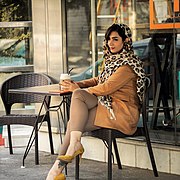Fashion in Iran has a cultural and economic impact on the county of Iran. During the Pahlavi era around the mid-1930s, Western fashion was introduced to the country (then called Persia) and greatly influenced women's style. After the Iranian Revolution in 1978–1979, the hijab has become compulsory, which impacted the creation of clothing style.
Beauty pageant festivals inside Iran were not held after the 1979 revolution, and the last selection ceremony of the beauty queen of Iran was held in 1978 in this country. After this, a high number of Iranian girls participated in the Beauty pageant and Miss Universe outside of Iran. Sahar Biniaz (Miss Universe Canada 2012) and Shermineh Shahrivar (Miss Germany and Miss Europe) are examples of Iranian models outside Iran. Social media networks have played a significant role in increasing the income from modeling in Iran. Additionally many Iranian fashion designers have found success living in the diaspora.
History
See also: Persian clothing, for clothing prior to 1930sWomen's fashion
See also: Women in Iran

Attempts at changing dress norms (and perspectives toward it) occurred in mid-1930s when pro-Western ruler Reza Shah issued a decree banning all veils. Many types of male traditional clothing were also banned. Western historians state that this would have been a progressive step if women had indeed chosen to do it themselves, but instead this ban humiliated and alienated many Iranian women, since its effect was comparable to the hypothetical situation in which the European women had suddenly been ordered to go out topless into the street.
A far larger escalation of violence occurred in the summer of 1935 when Reza Shah ordered all men to wear European-style bowler hat, which was Western par excellence. This provoked massive non-violent demonstrations in July in the city of Mashhad. This decision by Reza Shah was criticized even by British consul in Tehran. Later, official measures relaxed slightly under next ruler and wearing of the headscarf or chador was no longer an offence, but for his regime it became a significant hindrance to climbing the social ladder as it was considered a badge of backwardness and an indicator of being a member of the lower class.
A few years prior to the Iranian revolution, a tendency towards questioning the relevance of Eurocentric gender roles as the model for Iranian society gained much ground among university students, and this sentiment was manifested in street demonstrations where many women from the non-veiled middle classes put on the veil and symbolically rejected the gender ideology of Pahlavi regime and its aggressive deculturalization. Wearing of headscarf and chador was one of main symbols of the 1979 revolution, Wearing headscarves and chadors was used as a significant populist tool and Iranian veiled women played an important rule in the revolution's victory. Since hijab was legally imposed on all Iranian women in 1984, post revolutionary Iranian women's fashion has seen Iranian women attempt to work within the narrow confines of the Islamic modesty code, with the typical attire gradually evolving from the standard black chador to a rousari (simple headscarf) combined with other colorful elements of clothing.
Before the Iranian Islamic Revolution of 1979 (during the reign of Mohammad Reza Pahlavi, the last Shah of Iran), the hijab was not compulsory, though some Iranian women during this period wore headscarfs or chador.
After 1979 revolution and the hijab
| This section needs to be updated. The reason given is: Not covering new events -more about hijab-. Please help update this article to reflect recent events or newly available information. (February 2023) |
In Iran, since 1981, after the 1979 Islamic Revolution, the hijab has become compulsory. All women are required to wear loose-fitting clothing and a headscarf in public. In the Islamic law of Iran imposed shortly after the 1979 revolution, article 638 of 5th book of Islamic Penal Code (called Sanctions and deterrent penalties) women who do not wear a hijab may be imprisoned from ten days to two months, and/or required to pay fines from 50,000 up to 500,000 rials. Fines are recalculated in the courts to index for inflation. Article 639 of the same book says, two types of people shall be sentenced one year to ten years' imprisonment; first a person who establishes or directs a place of immorality or prostitution, second, a person who facilitates or encourages people to commit immorality or prostitution.
The festivals of the Beauty pageant inside Iran were not held after the 1979 revolution, and the last selection ceremony of the beauty queen of Iran was held in 1978 in this country. After this, a high number of Iranian girls participated in the Beauty pageant and Miss Universe outside of Iran. Sahar Biniaz (Miss Universe Canada 2012) and Shermineh Shahrivar (Miss Germany and Miss Europe) are examples of Iranian models outside Iran.
Girls of Enghelab was a series of protests against compulsory hijab in Iran. The protests were inspired by Vida Movahed, an Iranian woman known as the Girl of Enghelab Street, who stood in the crowd on a utility box in the Enghelab Street (Revolution Street) of Tehran on 27 December 2017, tied her hijab, a white headscarf, to a stick, and waved it to the crowd as a flag. She was arrested on that day and was released temporary on bail a month later, on 28 January 2018. Some people believe that Movahed's action was based on Masih Alinejad's call for White Wednesdays, a protest movement that the presenter at VOA Persian Television started in early 2017. Other women later re-enacted her protest and posted photos of their actions on social media. These women are described as the "Girls of Enghelab Street" and "The Girls Of Revolution Street" in the English sources.
Protests against the compulsory hijab have been common since 1979, with one of the largest protests taking place between 8 and 14 March 1979, beginning on International Women's Day and a day after hijab rules were introduced by the Islamic Republic. Protests against mandatory hijab rules continued, such as during the 2019–2020 protests, when protesters attacked a Guidance Patrol van and freed two detained women.
In 2020, two representatives of Iranian government leader Ali Khamenei separately said that improperly veiled women should be made to feel "unsafe". The representatives later backtracked and said that their comments were misunderstood. Among the general population, an independent survey conducted in the same year showed that 58% of Iranians did not believe in hijab altogether, and 72% were against compulsory hijab rules. Only 15% insisted on the legal obligation to wear it in public.
Iran has an advanced leather industry for women's clothing, however, it needs technology development for export.
-
 Common men's clothing in Tehran
Common men's clothing in Tehran
-
 Reza Golzar, actor and model
Reza Golzar, actor and model
-
 Fashion photography for sports outfit, near Milad Tower
Fashion photography for sports outfit, near Milad Tower
-
 Persian model in Tehran (September 2018)
Persian model in Tehran (September 2018)
-
 An Iranian woman in 2019
An Iranian woman in 2019
Persian boots

Ancient Persians used to wear leather high-heeled boots. Both Persian women and men wore varieties of "tall" boots. In modern era, boot became a main and common footwear among Iranian women, and this influenced the Iranian fashion industry. The sale of women's boots in Iran was reported ten times more than men's boots in a report in the 2000s.
One of the main features of Iranian women's fashion is wearing high-heeled boots. Although later hijab was considered to be the main feature.
Agencies and models
There is a range of fashion models from Iran (or of Iranian descent) that have made it to a high-level fame, such as Nazanin Afshin-Jam, Farzan Athari, Sahar Biniaz, Mandana Karimi, Aylar Lie, Leyla Milani, Shermine Shahrivar and Sadaf Taherian.
Social media
Social media networks have played a significant role in increasing the income from modeling in Iran. The influence of Instagram in the expansion of fashion photography in Iran has been mentioned by the Iranian media.
List of Iranian fashion designers
See also: Category:Iranian fashion designers- Farnaz Abdoli
- Ray Aghayan
- Haman Alimardani
- Bijan
- Cleopatra Broumand
- Melody Ehsani
- Paria Farzaneh
- Mimi Fayazi
- Shirin Guild
- Mehr Monir Jahanbani
- Keyvan Khosrovani
- Arefeh Mansouri
- Manny Mashouf
- Saul Maslavi
- Hushidar Mortezaie
- Tala Raassi
- Behnaz Sarafpour
- Maral Yazarloo
- Mahla Zamani
See also
References
- ^ Hoodfar, Homa (fall 1993). The Veil in Their Minds and On Our Heads: The Persistence of Colonial Images of Muslim Women, Resources for feminist research (RFR) / Documentation sur la recherche féministe (DRF), Vol. 22, n. 3/4, pp. 5–18, Toronto: Ontario Institute for Studies in Education of the University of Toronto (OISE), ISSN 0707-8412
- ^ Milani, Farzaneh (1992). Veils and Words: The Emerging Voices of Iranian Women Writers, Syracuse, New York: Syracuse University Press, pp. 19, 34–37, ISBN 9780815602668
- ^ Paidar, Parvin (1995): Women and the Political Process in Twentieth-Century Iran, Cambridge Middle East studies, Vol. 1, Cambridge, UK; New York: Cambridge University Press, pp. 106–107, 214–215, 218–220, ISBN 9780521473408
- ^ Majd, Mohammad Gholi (2001). Great Britain and Reza Shah: The Plunder of Iran, 1921–1941, Gainesville: University Press of Florida, pp. 209–13, 217–218, ISBN 9780813021119
- ^ Curtis, Glenn E.; Hooglund, Eric (2008). Iran: A Country Study, 5th ed, Area handbook series, Washington, DC: Federal Research Division, Library of Congress, pp. 28, 116–117, ISBN 9780844411873
- ^ Katouzian, Homa (2003). "2. Riza Shah's Political Legitimacy and Social Base, 1921–1941" in Cronin, Stephanie: The Making of Modern Iran: State and Society under Riza Shah, 1921–1941, pp. 15–37, London; New York: Routledge; Taylor & Francis, ISBN 9780415302845
- ^ Katouzian, Homa (2004). "1. State and Society under Reza Shah" in Atabaki, Touraj; Zürcher, Erik-Jan: Men of Order: Authoritarian Modernisation in Turkey and Iran, 1918–1942, pp. 13–43, London; New York: I.B. Tauris, ISBN 9781860644269
- ^ Katouzian, Homa (2006). State and Society in Iran: The Eclipse of the Qajars and the Emergence of the Pahlavis, 2nd ed, Library of modern Middle East studies, Vol. 28, London; New York: I.B. Tauris, pp. 33–34, 335–336, ISBN 9781845112721
- ^ El Guindi, Fadwa (1999). Veil: Modesty, Privacy and Resistance, Oxford; New York: Berg Publishers; Bloomsbury Academic, pp. 3, 13–16, 130, 174–176, ISBN 9781859739242
- ^ Heath, Jennifer (2008). The Veil: Women Writers on Its History, Lore, and Politics, Berkeley; Los Angeles: University of California Press, pp. 66, 252–253, 256, 260, ISBN 9780520255180
- ^ Chehabi, Houchang Esfandiar (2003): "11. The Banning of the Veil and Its Consequences" in Cronin, Stephanie: The Making of Modern Iran: State and Society under Riza Shah, 1921–1941, pp. 203–221, London; New York: Routledge; Taylor & Francis, ISBN 9780415302845
- ^ Beeman, William Orman (2008). The Great Satan vs. the Mad Mullahs: How the United States and Iran Demonize Each Other, 2nd ed, Chicago: University of Chicago Press, pp. 108, 152, ISBN 9780226041476
- Abrahamian, Ervand (2008). A History of Modern Iran, Cambridge, UK; New York: Cambridge University Press, pp. 84, 94–95, ISBN 9780521528917
- Gheiby, Bijan; Russell, James R.; Algar, Hamid (1990). "Čādor (2)" in Yarshater, Ehsan: Encyclopædia Iranica, Vol. IV, Fasc. 6, pp. 609–611, London; New York: Routledge & Kegan Paul, ISBN 9780710091321
- ^ Ramezani, Reza (spring 2007). Hijab dar Iran az Enqelab-e Eslami ta payan Jang-e Tahmili (Persian), Faslnamah-e Takhassusi-ye Banuvan-e Shi’ah 11, Qom: Muassasah-e Shi’ah Shinasi, pp. 251–300, ISSN 1735-4730
- Ramezani, Reza (2008). Hijab dar Iran, dar doure-ye Pahlavi-ye dovvom (Persian), Faslnamah-e Takhassusi-ye Banuvan-e Shi’ah , Qom: Muassasah-e Shi’ah Shinasi, ISSN 1735-4730
- El Guindi, Fadwa (1999). Veil: Modesty, Privacy and Resistance. Oxford; New York: Berg Publishers; Bloomsbury Academic. pp. 3, 13–16, 130, 174–176. ISBN 9781859739242.
- Abrahamian, Ervand (2008). A History of Modern Iran. Cambridge, UK; New York: Cambridge University Press. pp. 84, 94–95. ISBN 9780521528917.
- Ramezani, Reza (2010). Hijab dar Iran az Enqelab-e Eslami ta payan Jang-e Tahmili (Persian), Faslnamah-e Takhassusi-ye Banuvan-e Shi’ah , Qom: Muassasah-e Shi’ah Shinasi, ISSN 1735-4730
- Milani, Farzaneh (1992). Veils and Words: The Emerging Voices of Iranian Women Writers, Syracuse, New York: Syracuse University Press, p. 19, 34–37, ISBN 9780815602668
- "638". Book #5 of the Islamic Penal Code (Sanctions and deterrent penalties) (in Persian).
- "639". Book #5 of the Islamic Penal Code (Sanctions and deterrent penalties) (in Persian).
- "مسابقه ملکه زیبایی ایران در کانادا". رادیو فردا (in Persian). Retrieved 2020-06-19.
- "ملکه زیبایی ایرانیتبار در شو تلویزیونی "آلمان میرقصد"". Deutsche Welle (in Persian). 2016-08-11. Retrieved 2020-06-19.
- نیوز, اخبار روز ایران و جهان | آفتاب. "بازیگر ایرانی، دختر شایسته کانادا شد!؟ +عکس". fa (in Persian). Retrieved 2020-06-19.
- "In Tehran, New Hijab Protester Led Off By Police". VOA. Archived from the original on 10 April 2019. Retrieved 14 March 2019.
- Thirty-five Years of Forced Hijab: The Widespread and Systematic Violation of Women's Rights in Iran (PDF) (Report). Justice for Iran. March 2014. Archived (PDF) from the original on 19 January 2022. Retrieved 24 September 2022.
- Qiblawi, Tamara (20 February 2019). "Iranians attack police after women detained for wearing hijabs 'improperly'". CNN. Archived from the original on 23 June 2022. Retrieved 23 September 2022.
- Fazeli, Yaghoub (5 October 2020). "'Improperly veiled' women should be made to feel unsafe, say Iran supreme leader reps". Al Arabiya. Archived from the original on 16 June 2022. Retrieved 23 September 2022.
- Maleki, Ammar; Arab, Pooyan Tamimi (August 2020). IRANIANS' ATTITUDES TOWARD RELIGION: A 2020 SURVEY REPORT (PDF) (Report). The Group for Analyzing and Measuring Attitudes in IRAN (GAMAAN). Archived (PDF) from the original on 11 September 2022. Retrieved 25 September 2022.
- "The Observer view on the backlash in Iran following the death of Mahsa Amini". The Guardian. 25 September 2022. Archived from the original on 25 September 2022. Retrieved 25 September 2022.
- "صنعت چرم کشور در انتظار توسعه فناوری". ایرنا (in Persian). 2020-11-15. Retrieved 2022-08-25.
- ^ هشت هزار سال تارىخ پوشاک اقوام ايرانى - نسخه اصلاح و بهروزشده ۱۴۰۲ - ۴۵ تا ۵۶.
- YJC, خبرگزاری باشگاه خبرنگاران | آخرین اخبار ایران و جهان | (22 January 2022). "مدلینگ گرایی؛ باتلاقی مدرن در نزدیکی جوانان/ ژست بگیرید تا کسب درآمد کنید!". fa (in Persian). Retrieved 2023-06-16.
External links
 Media related to Fashion of Iran at Wikimedia Commons
Media related to Fashion of Iran at Wikimedia Commons
| Fashion articles | |||||||
|---|---|---|---|---|---|---|---|
| Index of fashion articles | |||||||
| General |  | ||||||
| History | |||||||
| Events | |||||||
| Industry |
| ||||||
| Traditional clothing |
| ||||||
| Casual |
| ||||||
| By country | |||||||
| Fashion activism | |||||||
| Related | |||||||